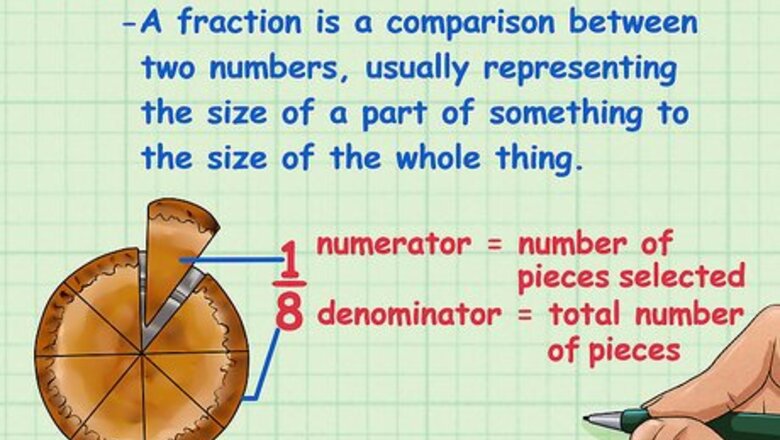
views
X
Research source
Converting Fractions and Decimals to Percentages

Review the general meaning of fractions. A fraction is a comparison between two numbers, usually representing the size of a part of something to the size of the whole thing. The classic example is a pie that is cut into eight, for example, equal portions. The top of the fraction, called the numerator, represents the number of pieces you select. The bottom of the fraction, called the denominator, represents the total number of pieces in the pie - in this case, 8. For example, the fraction 1/8 represents one piece of the pie that has been cut in eight pieces. The fraction 7/8 represents 7 pieces, almost the full pie.
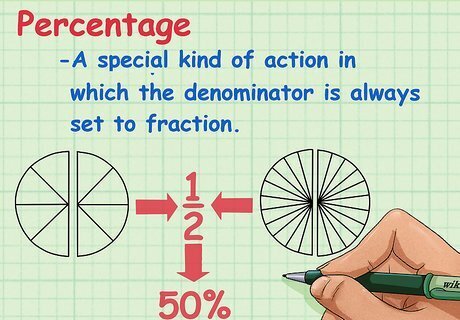
Recognize the special relationship of percentages. A percentage is a special kind of fraction in which the denominator is always set at 100. While this is not practical when cutting slices of an actual pie, the concept of percentages is much more useful because it is standard. With fractions, the size of “half” of something will depend on the number of pieces. If your “pie” is cut into 8 pieces, then half would be 4. But if your “pie” is in 22 pieces, then half would be 11. The target always changes. But with percentages, one-half is always the same - 50%. It's helpful to remember that the word "percent" actually means "of 100"—"per" means "of," and "cent" means "100."
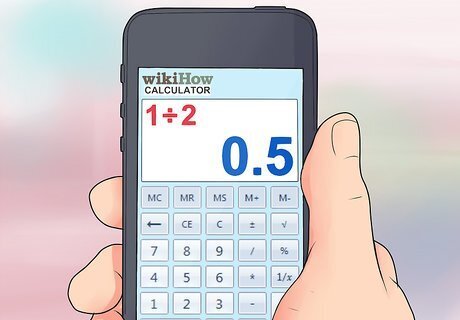
Use a calculator to convert any fraction to a decimal or percentage. If you are presented with any fraction, you can very easily convert it to a decimal number using any calculator. Just recognize that a fraction represents a division problem, and use your calculator to divide the numerator by the denominator. Your calculator will give you the decimal equivalent of the fraction. Suppose you have the fraction 1/2. On your calculator, perform the operation 1 ÷ 2, and the calculator will show the result 0.5. Convert the fraction 1/4 into a decimal by performing the operation 1 ÷ 4. The result is 0.25. For a more complicated example, you can convert the fraction 274/312 into a decimal with the operation 274 ÷ 312. The result will be 0.878. (There are more digits, but for our purposes we can stop at three.)
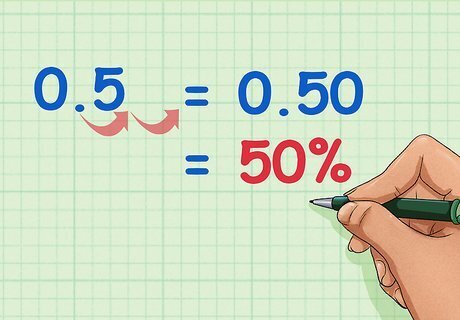
Convert decimals to percentages by shifting the decimal point. If you have a number that is already represented by a decimal, converting that to a percentage is easy. Because the decimal numbering system is based on factors of 10, you can transform a decimal number into a percentage by simply shifting the decimal point by two spaces to the right and then adding a % sign. If your decimal number consists of only one digit, you can add 0’s on the right of the number, such as turning 0.5 into 0.50 or even 0.500. These all have the same numerical value. Consider the example above of 1/2, which we converted to the decimal of 0.5. To change this decimal to a percentage, shift the decimal point two spaces to the right. First rewrite 0.5 as 0.50. Then when you shift the decimal point two spaces, you turn 0.50 into the number 50%. The example of 1/4, which has a decimal equivalent of 0.25, can be turned into the percentage 25%.
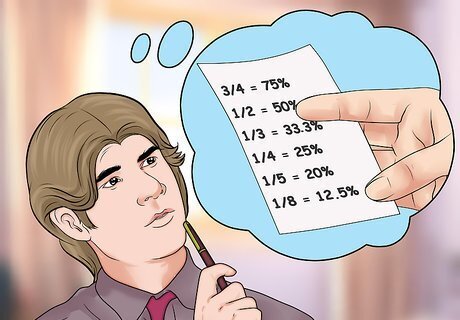
Memorize basic fraction conversions. It is useful if you can memorize the percentage representations of certain basic fractions. Because the denominator for a percentage is always 100, certain values are constant. Some basic conversions you should know include: 3/4 = 75% 1/2 = 50% 1/3 = 33 1/3% 1/4 = 25% 1/5 = 20% 1/8 = 12.5% (this is often used in banking)
Performing Basic Calculations with Percentages
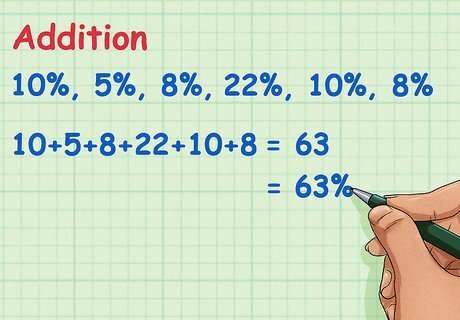
Add percentages very directly. Because percentages all represent fractions with the common denominator of 100, you can add a list of percentages without any additional work. By contrast, remember that to add fractions, you must work through the steps of finding common denominators and converting your fractions to those common denominators. With percentages, however, no additional work is necessary.Just add the numbers together. If each of six people draws a portion of the company’s payroll, you can find out how much they represent together by just adding the relative percentages. If their respective shares are 10%, 5%, 8%, 22%, 10% and 8%, you can just add 10+5+8+22+10+8 = 63. Those six people make up 63% of the company’s payroll. When you are adding, ignore the percent symbol, and just add the numbers. Put the symbol back in your final answer.
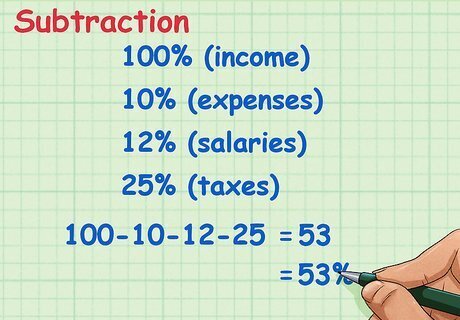
Subtract percentages in the same manner. Again, because percentages represent fractions with the common denominator of 100, you do not need to do any additional work to subtract percentages. If you are working the the concept of removing some percentage from an original whole item, you should represent the whole item with the number 100 (because the whole means 100%). Suppose you want to calculate an income percentage. 100% represents the entire income from some project, but then you must subtract, for example, 10% for expenses, 12% for salaries, and 25% for taxes. How much is left? Simply use your calculator to perform the subtraction of 100-10-12-25. The result is 53%.
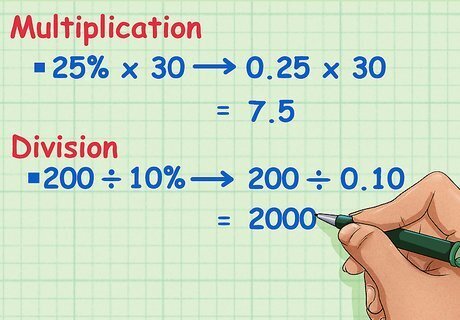
Multiply or divide using decimal equivalents. If you have a problem that is initially written as 25% x 30, just write the 25% as its decimal equivalent 0.25 and conduct the operation. This would be 0.25 x 30 which gives the result of 7.5. Similarly, if you have a division problem of 200 ÷ 10%, rewrite this as 200 ÷ 0.10 and enter this into your calculator. You will get the result of 2000. The last result may appear surprising, if you expect division to produce a smaller result than the starting number. However, you should understand that division by a number less than one will always lead to an increase by the reciprocal of that number. For example, dividing by 1/10 is the same as multiplying by 10. Dividing by 1/2 is the same as multiplying by 2.
Calculating a Percentage of a Whole Number
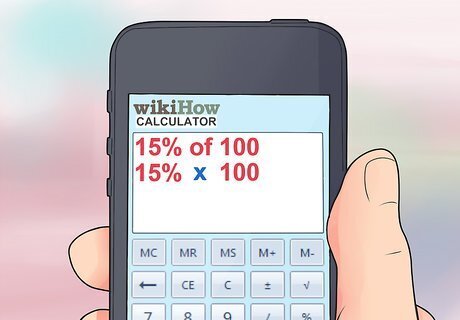
Perform multiplication to find the percent “of” a number. A common calculation involving percentages is to find some percent “of” another number. For example, if you are in a restaurant you may want to tip 15% “of” your total bill. When working with percentages, the word “of” carries the same meaning as “times” or “multiply.” Therefore, 15% “of” 100, for example, means the same as 15% x 100.
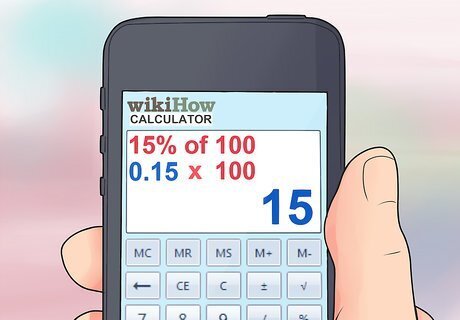
Convert the percentage to a decimal and multiply. To calculate the percentage of the whole number, you need to first turn the percentage into a decimal as already described. Then simply multiply. To find 15% of 100, rewrite the 15% as 0.15. Then just multiply 0.15 x 100, to get the solution of 15.

Write your result without a percentage symbol. When you set out to find a percentage of a whole number, your result will be a number and not a percentage. You may begin with a percentage symbol, but when you convert that percentage to a decimal to conduct the multiplication, your answer will no longer have a percentage symbol. In the example of 15% of 100, the result is the whole number 15.
Using the % Key on a Calculator
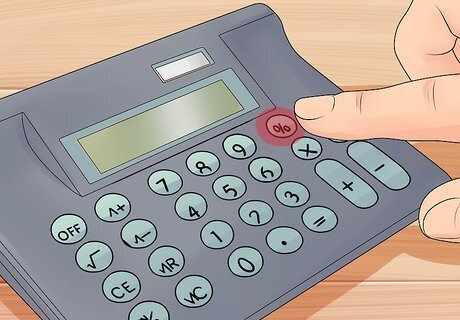
Find the % key on your calculator. Most simple calculators will contain a key with the % symbol. More advanced, graphing calculators may not have this key because the makers expect that you can operate without it. But many more basic calculators will have it.
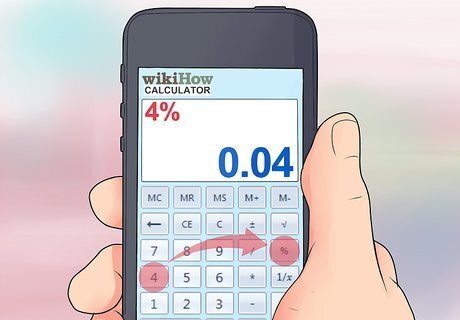
Experiment with the % key for decimal conversions. The simplest use of the % key is to convert any number from its percentage form to its decimal form. Just enter the number and press the % button, and the calculator will show the decimal equivalent. To represent the number 4% on your calculator, just press the button 4 and then %. Your calculator will turn the number 4 into 0.04, which is the decimal equivalent. To change the number 82.5% into a decimal, just type the buttons 8, 2, . , 5, %. The calculator will now show the value of 0.825.
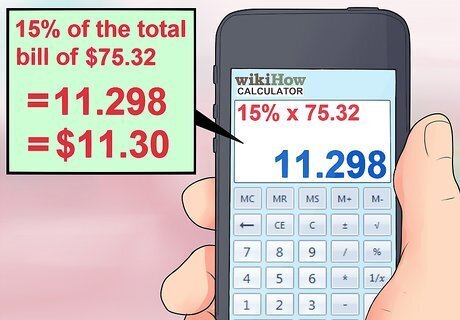
Use the % key for calculations. The % key on your calculator makes certain calculations very simple. Suppose you want to calculate a tip amount, and you want to find 15% of the total bill of $75.32. If you have your calculator available, you will enter the buttons 15% x 75.32. You should get the result of 11.298, which represents a tip of $11.30. Whenever you are using a calculator for percentage calculations, you should make sure to press the Clear (C) or All Clear (AC) button before starting. As you enter the numbers for this calculation, you should notice that as soon as your hit the % button, your number of 15 converts to .15. The calculator will the proceed to calculate .15 x 75.32.













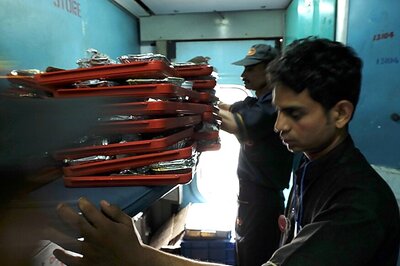






Comments
0 comment